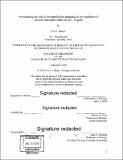| dc.contributor.advisor | Dennis H. Kim. | en_US |
| dc.contributor.author | Hilbert, Zoë A. ( Zoë Alyse) | en_US |
| dc.contributor.other | Massachusetts Institute of Technology. Department of Biology. | en_US |
| dc.date.accessioned | 2019-01-11T16:07:11Z | |
| dc.date.available | 2019-01-11T16:07:11Z | |
| dc.date.copyright | 2018 | en_US |
| dc.date.issued | 2018 | en_US |
| dc.identifier.uri | http://hdl.handle.net/1721.1/119981 | |
| dc.description | Thesis: Ph. D., Massachusetts Institute of Technology, Department of Biology, 2018. | en_US |
| dc.description | Cataloged from PDF version of thesis. | en_US |
| dc.description | Includes bibliographical references. | en_US |
| dc.description.abstract | Sexual dimorphisms are a fundamental feature of the nervous systems of diverse animal species and the identification and functional characterization of such features is critical to our understanding of differences in behavior between the sexes. While sexual dimorphisms in nervous system organization and morphology can contribute to behavioral differences, increasingly, roles are being defined for more subtle differences in the regulation of sexually dimorphic behaviors. Chapter One of this thesis discusses sexual dimorphisms in the nervous systems and behaviors of several species, with particular focus on work in the nematode, Caenorhabditis elegans. In Chapter Two, we show that sexual dimorphism in a central neuroendocrine signaling pathway in C. elegans is essential for establishing sex differences in decision-making behaviors. We demonstrate that the DAF-7/TGF-[beta] ligand is dimorphically expressed in a pair of sensory neurons, the ASJ neurons, in adult male animals and functions to promote male-specific food-leaving behavior. We show that regulation of this expression pattern and the corresponding behavior is dependent on the sex of the animal as well as additional features of its physiological state and its microbial environment. Our work suggests that hierarchical processing and integration of multiple sensory cues within a pair of sensory neurons terminates in transcriptional activation of this neuroendocrine signal, which can help the animal to make behavioral decisions, including whether to stay in a food source or to explore away from it. Defining the genetic pathways that regulate daf- 7 expression in ASJ may provide clues not only to how sexual differentiation occurs in these neurons to promote sex-specific behaviors, but may also inform our understanding of how multiple sensory stimuli are integrated to allow for behavioral adaptation. In Chapter Three, we identify a role for another neuroendocrine signaling pathway, the PDF- 1 neuropeptide pathway, in the sex-specific regulation of daf- 7 expression. Our results demonstrate that neuroendocrine modulation of sex-shared neurons can have profound effects on sexually dimorphic gene expression and behavior. Finally, in Chapter Four, I discuss future directions for this project which include further genetic analysis of daf-7 regulation and aim to provide insight into a range of neurobiological questions in C. elegans. | en_US |
| dc.description.statementofresponsibility | by Zoë A. Hilbert. | en_US |
| dc.format.extent | 140 pages | en_US |
| dc.language.iso | eng | en_US |
| dc.publisher | Massachusetts Institute of Technology | en_US |
| dc.rights | MIT theses are protected by copyright. They may be viewed, downloaded, or printed from this source but further reproduction or distribution in any format is prohibited without written permission. | en_US |
| dc.rights.uri | http://dspace.mit.edu/handle/1721.1/7582 | en_US |
| dc.subject | Biology. | en_US |
| dc.title | Investigating the role of neuroendocrine signaling in the regulation of sexually dimorphic behavior of C. elegans | en_US |
| dc.type | Thesis | en_US |
| dc.description.degree | Ph. D. | en_US |
| dc.contributor.department | Massachusetts Institute of Technology. Department of Biology | |
| dc.identifier.oclc | 1080642770 | en_US |
